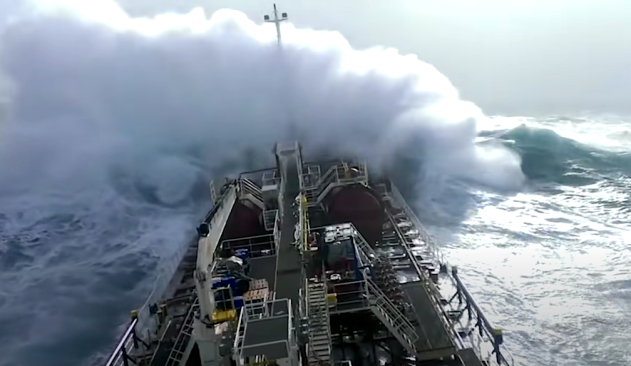Video shows tanker nearly swallowed up by monstrous waves in North Atlantic
The North Atlantic is not a welcoming place for seafarers. The massive body of water is notorious for brutal weather that can create dangerous shipping conditions over hundreds if not thousands of miles.
AccuWeather meteorologists say this is thanks in part to intense areas of low pressure that form across the basin. These areas of low pressure can kick up potent winds that can stir up the seas and create enormous waves, often to the detriment of ships and their crewmembers on board.
On April 29, a tanker was caught up in extremely turbulent weather and one of the crew members recorded video of the frightening scene. As the ship was crossing the North Atlantic, it was struck by a series of large waves in what looked like a scene straight out of the 2000 film The Perfect Storm.
 |
A chemical tanker ship seen navigating monstrous waves amid extremely rough seas in the North Atlantic during late April 2021. (Reuters via Newsflare) |
Footage captured by one of the sailors on board showed the ship bobbing up and down amid the angry ocean as ferocious waves pounded the ship repeatedly and gusty winds howled.
"As storm systems strengthen across the North Atlantic wind gusts can reach or even surpass hurricane-force (74 mph or 119 km/h), which work to kick up very large swells," said AccuWeather Senior Meteorologist Tyler Roys.
Waves can build to more than 50 feet (15 meters) across the open expanse of ocean stretching from eastern Canada to western Europe.
"These swells can propagate away from the storm hundreds of miles," Roys added.
CLICK HERE FOR THE FREE ACCUWEATHER APP
Large waves are no stranger to the North Atlantic. On Feb. 4, 2013, a significant wave height of 62 feet (19 meters) was reported by a buoy across the North Atlantic located between Iceland and the United Kingdom, according to the World Meteorological Organization (WMO). That wave holds the record for the largest significant wave height measured by a buoy in the North Atlantic.
That wave, however, pales in comparison to a 76-foot (23.4-meter) wave measured by a buoy in 2014, according to a BBC report. The WMO noted that this wave was not measured using "significant wave height," which required certain measuring methods and observing periods.
The world record for highest significant wave height by ship observation is also from the North Atlantic. On Feb. 8, 2000, a wave of 60.7 feet (18.5 meters) was recorded.
Advanced technology has allowed scientists to get even closer to nature and capture never-before-seen video footage. In September 2021, a drone ship -- the Saildrone Explorer SD 1045 -- was able to capture, for the first time, footage from the eye of Hurricane Sam, a Category 4 storm in the Atlantic Ocean.
And in February 2022, oceanographers published a study detailing what they said could be the "most extreme" rogue wave ever observed. The rogue wave occurred in November 2020 in the waters offshore from British Columbia, Canada, and was recorded by a buoy. According to the scientists, the wave reached a height of 58 feet -- not the tallest wave ever observed, but proportionally more extreme than the nearby waves surrounding it. "The probability of such an event occurring is once in 1,300 years," the lead author of the study said about the rogue wave.
For the latest weather news check back on AccuWeather.com. Watch the AccuWeather Network on DIRECTV, Frontier, Spectrum, fuboTV, Philo, and Verizon Fios. AccuWeather Now is now available on your preferred streaming platform.


